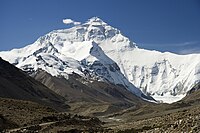
The 1933 British Mount Everest expedition was, after the reconnaissance expedition of 1921, and the 1922 and 1924 expeditions, the fourth British expedition to Mount Everest and the third with the intention of making the first ascent.
Like the previous expeditions to climb the mountain, the 1933 expedition was unsuccessful, although in two separate attempts Lawrence Wager and Percy Wyn-Harris, and then F. S. Smythe, set an altitude record for climbing without supplemental oxygen that was not broken until Reinhold Messner and Peter Habeler reached the summit of Mount Everest in 1978.[1] During Wager and Wyn-Harris's attempt, the ice-axe belonging to Andrew Irvine, who disappeared with Mallory on the 1924 attempt while going for the summit, was found on the flanks of the north face.
- ^ Glasby (2008).